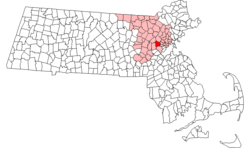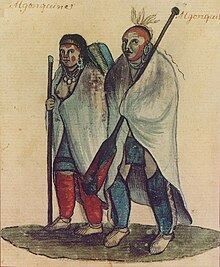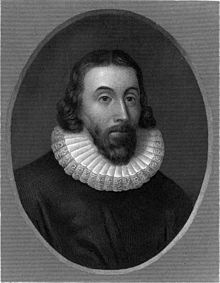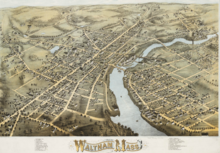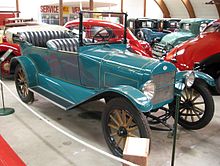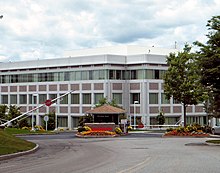Waltham, Massachusetts
| Waltham | |
|---|---|
| Nickname : The Watch City | |
 Looking across the Charles River to Waltham |
|
| Location in Massachusetts | |
| Basic data | |
| Foundation : | 1634 |
| State : | United States |
| State : | Massachusetts |
| County : | Middlesex County |
| Coordinates : | 42 ° 23 ′ N , 71 ° 14 ′ W |
| Time zone : | Eastern ( UTC − 5 / −4 ) |
| Residents : | 59,226 (as of: 2000) |
| Population density : | 1,800.2 inhabitants per km 2 |
| Area : | 35.2 km 2 (approx. 14 mi 2 ) of which 32.9 km 2 (approx. 13 mi 2 ) is land |
| Height : | 15 m |
| Postcodes : | 02451-02454 |
| Area code : | +1 339, 781 |
| FIPS : | 25-72600 |
| GNIS ID : | 0612400 |
| Website : | www.city.waltham.ma.us |
| Mayor : | Jeannette A. McCarthy |
Waltham is a city in the south of the US state Massachusetts . The area on the Charles River has been settled by European emigrants since 1634. Waltham received city rights in 1884. Waltham is one of the state's "Mill Towns"; H. a place that was originally formed around a mill , a sawmill or a factory , and an early center of US industrialization , initially in the textile sector. The first modern factory in the USA is located here (1814) and the chalk pencil was invented and manufactured industrially for the first time (“Waltham Crayon”, later “American Crayon”). The city was best known for the Waltham Watch Company , which existed from 1854 to 1957 and produced over 40 million watches. At the beginning of the 20th century, Waltham was part of a center of the automotive industry, but with the rise of Detroit it quickly lost its importance.
Brandeis University is located in Waltham . Because of the former watchmaking, Waltham is also called "the watch town".
Established businesses
- Alere , medical technology company
- Novell , manufacturer of network and Internet software products
- Parexel , one of the leading clinical trial companies
- Raytheon , defense and electronics company
- Thermo Fisher Scientific , biotechnology company
history
There is archaeological evidence that Leif Eriksson (around 975-around 1020) and his Normans set foot on the American mainland around the year 1000. However, it is controversial that they also, as rumored, reached the region around Waltham.
When European settlers came to the area in the 1620s, the land appears to have been populated by Algonquin . As early as 1627, an administrative district Watertown was created, which, in addition to the area on which the city of the same name is located today , also includes territories of Waltham, Weston and parts of Belmont , Lincoln and Cambridge . In 1629 Puritans settled here under the leadership of John Winthrop (1588–1649). The first registered land buyer in the Waltham area was Captain John Oldham (April 1634). He was murdered by Indians on Block Island on July 20, 1636 . In the already tense situation between the Native American Indians and British colonists, this incident sparked the Pequot War of 1637, which is considered the first armed conflict between these two groups.
The first "resident" with permanent residence in what is now the city area was Edward Garfield (1650). The Waltham area was little affected by the uprising of 1675–1676 ; in April 1676 a barn was set on fire. In 1733, the small settlement community hired a teacher for the first time and a little later built the first school. In 1738 the municipality was named "Town". On November 20, 1761, the first urban bridge over the Charles River was inaugurated.
Wars of Independence
The gunshot, which was heard around the world , was also heard in Waltham. Citizens of Waltham took part in the battles of Lexington and Concord on April 19, 1775 at the beginning of the American Revolutionary War; In 1776 there were already over 200. In 1779 the foundation stone for industrialization was laid with the construction of a paper mill on the Charles River; others soon followed. The population was 1790 882 people.
Waltham Bleachery
The future governor Christopher Gore built a dam and a paper mill in 1794. The Waltham Bleachery and Dye Works were the first of its kind to be built on this site in 1820 . The textile finisher built a very innovative factory and stayed in town for 131 years. After the closure in 1951, the area was taken over by Raytheon .
Boston Manufacturing
In 1798 the first library in town was set up at the Waltham Social Club . In the same year John Bois sold his paper mill to Joshua Thomas , who added a spinning mill and sold the business in 1813 to the Boston entrepreneur Francis Cabot Lowell (1775-1817). This had begun in 1812 with attempts at the industrial production of cotton fabric , an undertaking that was hampered by the British-American War of 1812-1814. His Boston Manufacturing Company (BMC), founded with US $ 100,000, moved into its new type of factory in 1814 , in which for the first time the entire manufacturing process from raw cotton to the finished fabric took place under one roof and all work stations were equipped with power transmission belts. The principle went down in economic history as the Waltham-Lowell system . The company was also organized according to principles that are still valid today: shares were issued and the factory was first run by employees, not the owners or their relatives. From this it can be deduced with some justification that this factory was the first modern factory and can therefore be considered one of the triggers of the industrial revolution . Boston Manufacturing initially employed women from the north of the United States. In 1816 the company acquired the first fire extinguishing syringe ; The city's official fire brigade was not set up until the following year. A wage deduction, perceived as unfair, led to a stoppage of textile workers at Boston Manufacturing in 1820 , which went down as the first industrial strike in history. The company was possibly the first to support its local municipality with the construction of buildings such as churches, libraries or community halls and to provide accommodation for its own workers. It employed 2000 people in 1885. Boston Manufacturing existed until 1930. The factory building is still standing; since 1978 it has been used as a senior citizens' residence.
Industrial pioneers
In 1831 St. Mary's Church was built by Irish immigrants. It burned down in 1840; the following year the municipality recorded 6 churches, 46 shops and 275 permanent buildings. With The Hive Waltham in 1833 was the first local newspaper and the Waltham Bank was opened 1836th The invention of a process for the production of chalk pencils in 1835 by the Walthamer dentist Dr. Francis F. Field led to its on-site production, initially by the Parmenter, Powell & Powers Company ; the pens became known under the brand name Waltham Cayons . In 1843 the Boston, Clinton, Fitchburg and New Bedford Railroad was led to Waltham. In this operation Boston Manufacturing successful lobbying to achieve a budget for them lines. In 1846 tourist tours with a steamboat were taken on the Charles River. In 1849 the parish was enlarged by 600 acres (approx. 243 ha ) in the south through the purchase of land from the neighboring Newton municipality . Various companies settled here, such as the Newton Waltham Gas Light Company in 1853 , whose first customers, in addition to private households, included Boston Manufacturing . The aforementioned Parmenter, Powell & Powers Company also built a new building here, which they used until they left the city in 1875.
Irish Catholics, mostly working class, now made up 25% of the population.
Waltham Watch Company
In 1853, a Newton Waltham Gas Light Company plant was established to supply the city with coal gas. Aaron Lufkin Dennison (1812–1895) founded the Waltham Improvement Company in 1854 from which the Waltham Watch Company emerged in 1857 . This company was the first to manufacture high quality clocks in an industrial way and introduced interchangeability of all components. For decades the company was the largest employer in town with 4,000 employees in 1897 and is considered the largest watch factory of its time; In 1896 and 1897, 500,000 watches were made each. Waltham Watch made the 8 millionth watch in 1897. The company had to file for bankruptcy on December 28, 1948 , but existed under new management as Waltham Precision Instrument Company until 1957. The watch production was given up in 1954. A total of 40 million watches are said to have been produced. Waltham Watch also made wall clocks, tachometers , time fuses, and precision instruments.
Civil War (1861-1865)
The state of Massachusetts pioneered the abolition of slavery . Governor Nathaniel Prentiss Banks (1816-1894) was named by President Lincoln to one of only three major general of the volunteer army (Major General of Volunteers). The popular politician and skilled organizer was rather unsuccessful as a military leader. The place itself was spared from the chaos of war, although several citizens died in battle. Waltham set up its own company, Company H, 16th Massachusetts Volunteers Infantry of Waltham . She was commanded by Captain Gardner Banks , a brother of the governor. The uniforms were sewn on site and the soldiers were drilled here.
Progress in Waltham
In 1868 a horse-drawn tram went into operation and in 1871 the municipality procured the first fire fighting vehicle with a steam pump for the extinguishing water . In 1881 Waltham was connected to the Central Massachusetts Railroad . Another newspaper, the Waltham Daily Tribune , first appeared in 1882. That year, the first local telephone company was established. At Christmas 1886 the electrical street and shop window lighting was switched on for the first time. In 1873 a drinking water supply was established from the Charles River. It comprised a pipe and pump system with a filter system and was in operation until 1949.
The good medical care of the population at the time was further improved by the hospital opened in 1887 . The driving force, Dr. Alfred Worcester , had successfully performed one of the first appendix operations in the USA in 1884 . Waltham was also known through a nursing school. The hospital was closed in July 2003.
The Central Park theme park with the horse racing track of the same name opened in 1875, the Music Hall in 1880 and the Maple Grove Ice Rink in 1883.
City of Waltham
In 1884 Waltham became a City , which resulted in an administrative reform with the introduction of a mayor's office and a city council . Byron B. Johnson , attorney , was elected first mayor . This had represented the interests of Sergeant Boston Corbett in 1865 , who, contrary to his orders, had shot John Wilkes Booth (1838-1865) when he opposed his arrest. Booth was the assassin who previously shot President Lincoln . For Corbett, it was also about the US $ 75,000 government reward.
In 1885 a woman was elected to a public office in the city (school inspectorate) for the first time. Between 1890 and 1896 the tram was electrified and led to Newton . In 1896 Waltham had 22,000 residents. In 1905 the place received the first branch of a nationally active chain of stores with a Woolworth branch . From 1910, more and more Italian workers immigrated. In 1917 a chamber of commerce was established.
Early center of vehicle construction
In Waltham there were at least two larger bicycle factories before the turn of the 20th century: The American Waltham Manufacturing Company manufactured them under the brand name Comet, and the Waltham Manufacturing Company , founded in 1884 , began building the Orient in numerous variants from 1893 . This company, co-founded by Charles Herman Metz (1863–1937), produced 30,000 bicycles in 1896. Former employees of the company founded the Waltham Automobile Company , the 1898-1902 or 1903 steam car brands Tinker & Piper , Waltham Steam and for a short time American Steam manufactured. A steam car has now also been developed by American Waltham Manufacturing and sold as American Waltham . It had two machines and was even lighter than the Waltham Steam . After the merger of the manufacturer with the one from Boston had moved New England Motor Carriage Company in 1899 its production was stopped and instead of brought New England Steam produced; this from 1900 to 1901 for the Stanton Manufacturing Company .
Waltham Manufacturing Company
The situation at Waltham Manufacturing was just as complicated . Before the company became by far the largest automaker in the city, Metz constructed one of the first motorcycles in the USA in 1898 ; the vehicle built for standing races required two people to operate. This was followed by motorized tri and quadricycles and automobile prototypes with electric and combustion engines . Albert Champion (1878–1927) was also part of the successful motorsport team at times . CHMetz left the company in a dispute to found the Waltham Development Company in town . Waltham Manufacturing was successful for a number of years with the Orient Buckboard , a primitive but extremely inexpensive mini car. Then the company took over. It was facing bankruptcy when Metz returned and restructured it in no time. His innovative approach was to reduce the huge inventory of materials by selling his vehicles throughout the USA as DIY kits. With their own contribution, the customer got a full-fledged small car at an unbeatable low price. The steering wheel was in the last partial delivery ...
The company was reorganized as the Metz Company and the vehicles now offered as Metz remained successful for several years, even if the modular principle was quickly ended. Metz bought Governor Gore's estate in 1911 and hosted New England's first air show there in June 1911. its own attempts as an aircraft manufacturer were less successful, but after the USA entered the First World War , the company built around 1,000 fighter aircraft for the government. After the war, the end came for the Metz Company . Charles Metz drove the last vehicle produced to Glendale, California , where he set up a furniture factory.
Between the wars
1919 Waltham received a forest management. In the same year there was a large suffragette rally, at which the activist Florence Hope Luscomb (1887–1985) from Lowell (Massachusetts) spoke. The municipal garbage disposal was set up in 1922. A new town hall was opened in 1927 and in 1929 Anna Worcester Fogg moved in as the first elected councilor. The long-established Boston Manufacturing Company closed the following year ; 350 employees lost their jobs in a difficult environment: at the end of 1929 the global economic crisis broke out. In 1933 Raytheon moved its headquarters from Cambridge, Massachusetts to Waltham where it still exists today. On October 23, 1936, President FD Roosevelt made a high profile speech in Waltham on the occasion of his re-election campaign.
Waltham in World War II
Many Waltham citizens also served in the Army, Navy, and Air Force during World War II . Over 100 did not return. The Navy member James J. Fahey (1918–1991) became known, who published a widely read war diary.
The modern Waltham
In 1947 Waltham received a waste incineration plant. An explosion at the Makalot Plastic Company on South Street claimed five lives on March 6, 1948. Brandeis University was officially opened on October 7th . In 1949, Waltham joined a water system because its own drinking water contained too much iron. Route 128 was opened in 1951 , of which there are three exits in the city of Waltham today. The TV broadcaster WGBH started operations in 1955 from a system on Great Blue Hill .
Attractions
- Gore Place Mansion, 52 Gore Street
- Beaver Brook reservation
- The Waltham Museum, 25 Lexington Street, Waltham MA
- Charles River Museum of Industry and Innovation (CRMI), 154 Moody Street, Waltham MA
sons and daughters of the town

- Keith Aucoin (born 1978), ice hockey player
- Nathaniel Prentiss Banks (1816–1894), Governor of Massachusetts, General of the Union Army, member of the House of Representatives
- James Chirillo (* 1953), jazz guitarist, banjo player, arranger and composer
- Effie C. Carlton (1856-1940), b. Crockett, stage actress and composer (" Rock-a-bye Baby ")
- Abner Doble (1890–1961), entrepreneur, engineer, inventor, automobile pioneer (cf. Doble (car brand) )
- Christopher Gore (1758–1827), Governor of Massachusetts, diplomat, member of the US Senate, federal attorney, member of the Massachusetts Constituent Assembly, member of the House and Senate of Massachusetts
- John Peabody Harrington (1884–1961), linguist and ethnologist
- Henry B. Hill (1849-1903), chemist
- Roger Sherman Hoar (1887–1963), engineer, patent lawyer, politician and science fiction author
- Clarence Hobart (1870-1930), tennis player
- Deena Kastor (* 1973), long-distance runner
- Rebecca Kilgore (* 1948), jazz singer
- Joseph T. Lawless , marksman, 1920 Olympic champion over 1000 yards
- Samuel Livermore (1732–1803), US Senator and MP; Co-author of the US Constitution
- Robert Luce (1862–1946), politician, member of the US House of Representatives
- Shawn McEachern (* 1969), ice hockey player and coach
- Angelo Mosca (* 1937), football player and wrestler
- Annie Payson Call (1853–1940), columnist, author, and headmistress
- Thomas Joseph Riley (1900–1977), Auxiliary Bishop in Boston
- Tom Rooney (1881–1939), racing car driver and designer
- Cynthia Sayer (* 1962), musician
- Ernest G. Small (1888-1944), Rear Admiral
- Frederic Charles Smerlas (born 1957), football player
- Caroll Spinney (1933–2019) Puppeteer from the US television series Sesame Street, where he played Big Bird and Oscar the Grouch from 1969 .
- Brian Strait (born 1988), ice hockey player
- Edmund T. (Theodore) Williams (February 10, 1888 - August 21, 1986), chemist, patron of the American Jewish Historical Society Museum, Waltham , founder of the Via Biona Health Institute / Boston
Web links
- The Waltham Museum, 25 Lexington Street, Waltham MA (accessed April 18, 2013)
- Homepage of the Charles River Museum of Industry & Innovation in Waltham (accessed April 18, 2013)
- waltham-community.org: Key dates in the history of Waltham, Massachusetts (accessed January 21, 2014)
- Waltham Museum: Timeline (accessed January 21, 2014)
- Waltham International SA
- NAWCC: National Association of Watch & Clocks Collectors
- Waltham Museum: Waltham Watch Company (accessed April 18, 2013)
- Waltham Museum: Families (accessed January 20, 2014)
- Waltham Museum: Industry (accessed January 19, 2014)
- Waltham Museum: Military (accessed January 22, 2014)
- wikisource.org: The_Encyclopedia_Americana (1919–1920): Lowell, Francis Cabot (English) (accessed January 19, 2014)
- PRINT: The Crayon in the Room: Waxing Eloquently (accessed January 19, 2014)
- Waltham Daily Tribune / Wicked Local homepage (accessed January 19, 2014)
- Gutenberg Project: Annie Payson Call (accessed January 22, 2014)
Individual evidence
- ↑ a b c d e f Waltham Museum: History (timeline)
- ↑ a b c d e f g h i j k l m n o p q r s t u v w x waltham-community.org: Key dates; history of Waltham
- ↑ a b c d e Waltham Museum: Industry
- ↑ The_Encyclopedia_Americana (1919-1920): Lowell, Francis Cabot
- ^ PRINT: The Crayon in the Room: Waxing Eloquently
- ^ Waltham Museum: Military
- ^ Waltham Museum: Metz Company
- ^ Gutenberg Project: Annie Payson Call
